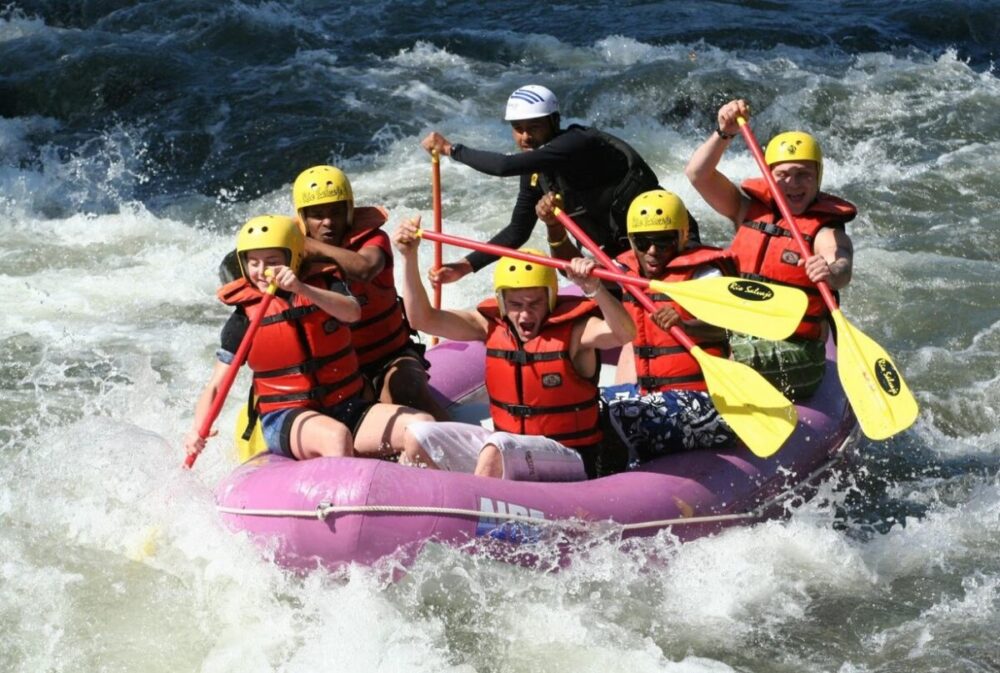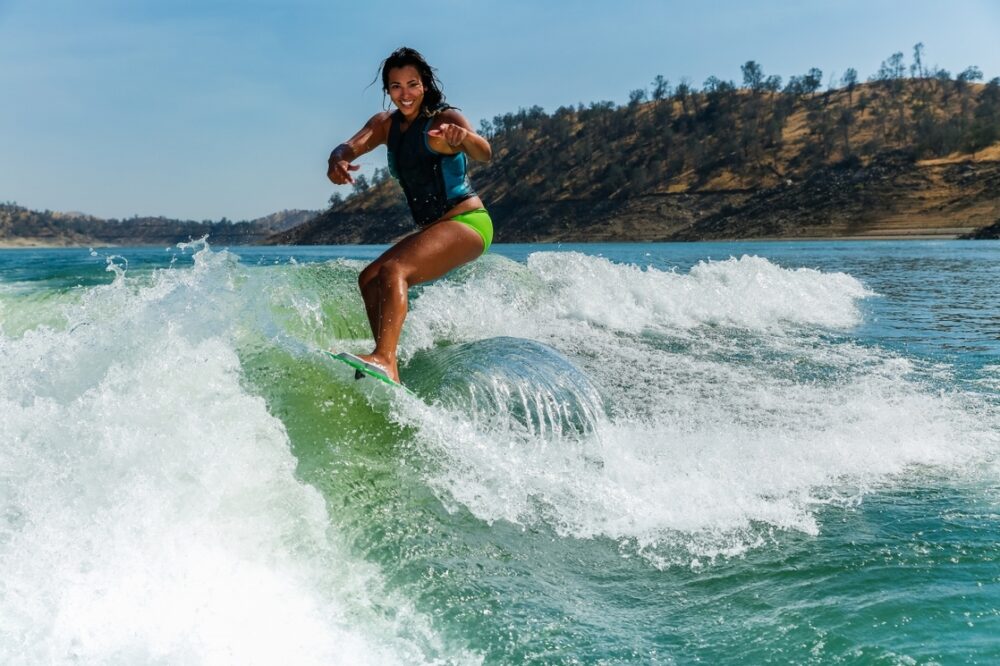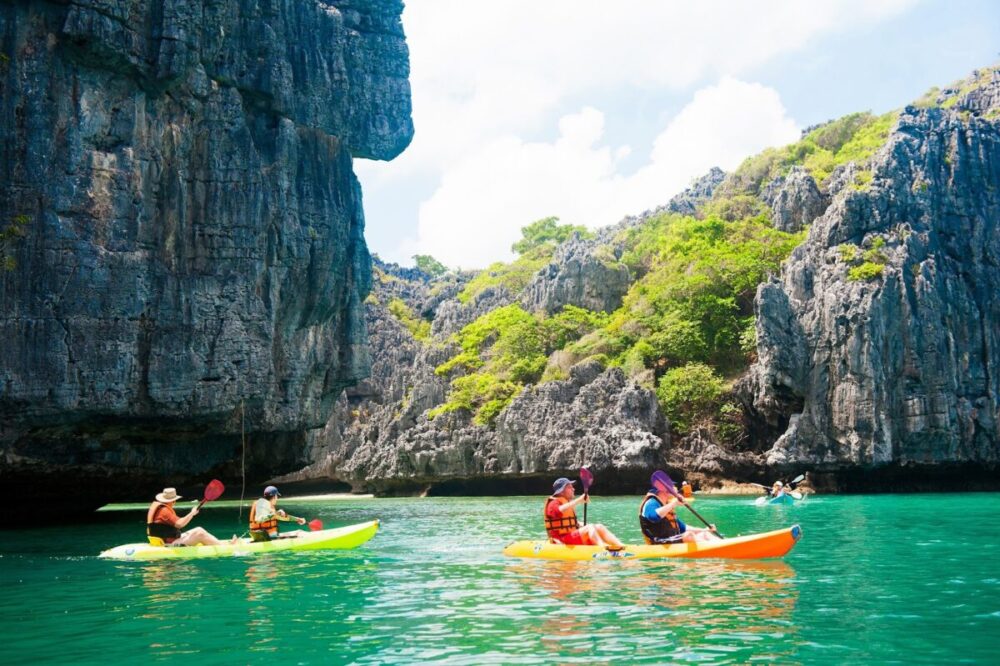Whitewater rafting may be an Olympic sport, known as whitewater slalom in the big leagues, but it’s a fun activity that almost anyone can enjoy.
The sport’s been around since the 1940s when the first thrill-seekers decided to take a raft, originally designed for river surveying, on a fun jaunt down the Salmon River in Idaho.
Since then tens of thousands of people have enjoyed this exciting outdoor pastime.
Have you decided to join these throngs of adventurers? If so, here’s what you need to know about river rafting.
Choose Your Adventure Wisely
If you want to enjoy a positive – and safe – experience out on the water, it’s important to educate yourself beforehand.
Anyone can take part in white water rafting, as long as you choose the right guides, a suitable experience, and a river that matches your abilities.
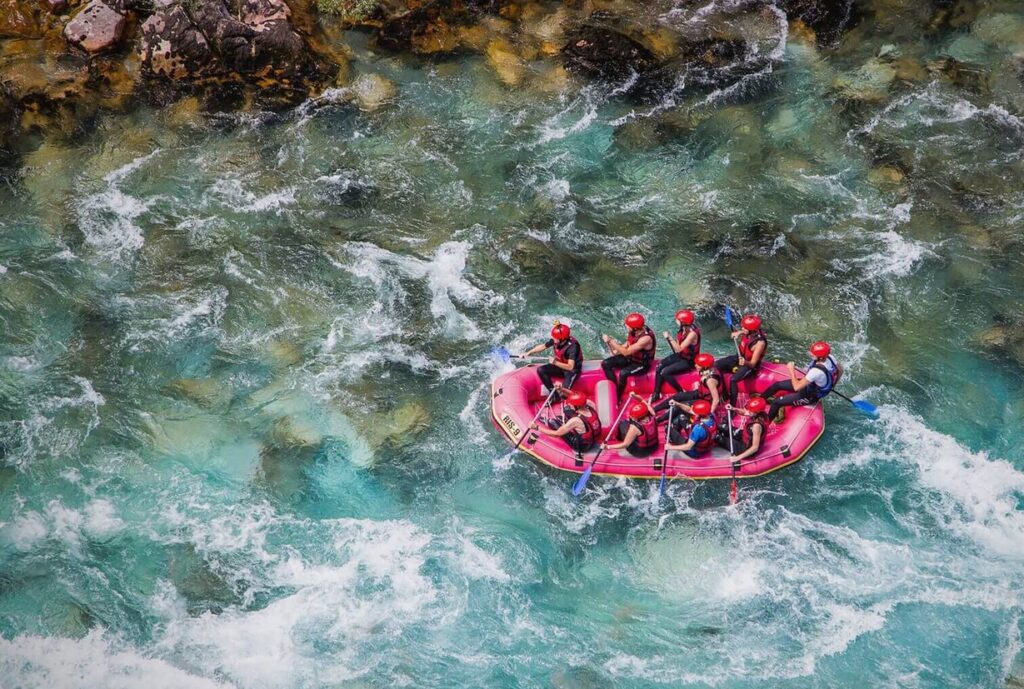
Choose a Top Class Outfitter
Take time to do some research before selecting someone to take you on your first adventure into the world of whitewater rafting.
Always choose a licensed and experienced operator and ask as many questions as you need to before booking your trip. Ask about their guides’ qualifications and experience.
Get references and look up online reviews about other people’s experiences with them.
Picking the right outfitter not only affects how much you’ll enjoy your rafting trip but it makes a world of difference to your safety too.
Types of Whitewater Rafting Trips
There are a variety of whitewater rafting trips to choose from. You can head off on a day trip lasting a half- or a full-day or take a multi-day journey down the river.
Day trips are fun events where you can get to know the ropes about river rafting. They can vary from a gentle float downriver to an action-packed day full of gushing rapids and non-stop action.
Usually, your tour operator will provide drinks and snacks to fuel your exertions throughout the day.
On multi-day outings, you’ll camp alongside the river every night and spend most of the day on the water. You’ll also get the opportunity to hike in the surrounding countryside and spend time at leisure.
Often, you’ll need to help set up camp and prepare meals on multi-day trips too.
These extended adventurers are a wonderful opportunity to spend time in nature and escape from modern-day trappings and stresses for a while.
Like day trips, multi-day trips can also vary in intensity.
Be honest about your abilities and fitness when choosing a rafting trip. Even a gentle outing can be strenuous thanks to the unfamiliar range of activities.
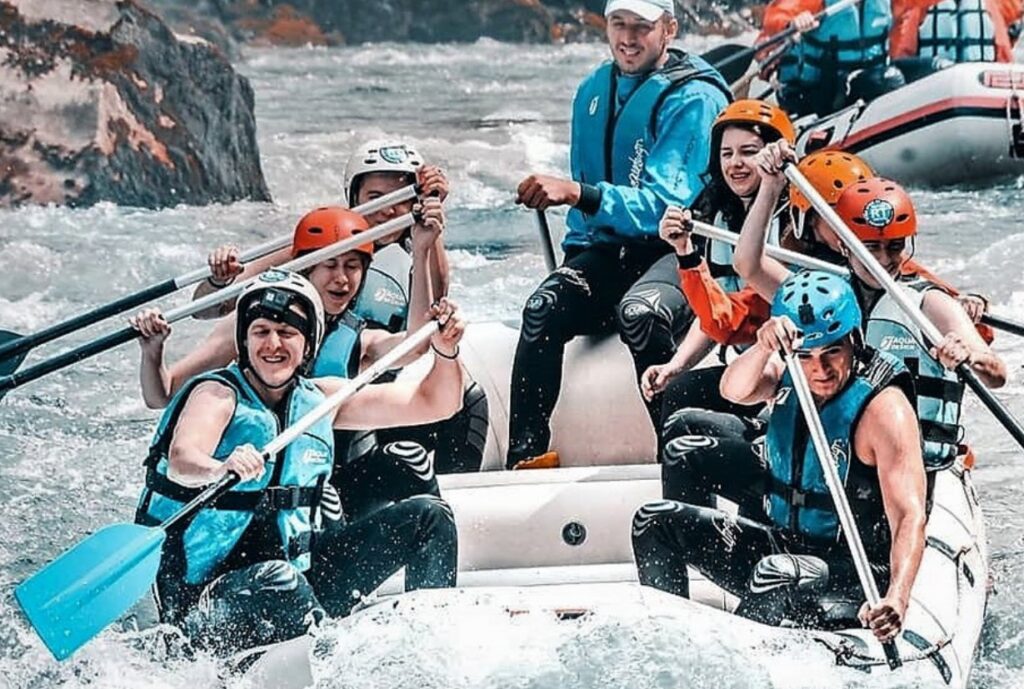
River Classifications
Each river poses unique challenges and can vary from one extreme to the next in an instant. So, to increase safety and prevent unpleasant surprises, all rafting rivers fall into one of five categories according to a standardized rating system.
These classifications range from I being the mildest to V, which is the most extreme.
The lowest-rated rivers are gentle and meandering with only a few mildly bumpy sections along the way. Rivers with a V classification are extremely challenging, featuring very rough rapids and even small waterfalls.
Many of the larger rivers have more than one rating, depending on where you’re rafting. These are some of the better-known rafting rivers and their classifications:
- Arkansas River, Colorado rated II to V
- Chattooga River, Georgia and South Carolina rated III to IV
- Gauley River, West Virginia rated IV to V
- Kennebec River and Dead River, Maine rated II to IV
- Nahatlatch River, British Columbia rated IV
- Rio Santa Maria, Mexico rated III to IV
- Salmon River, Idaho rated III to V
- The Grand Canyon section of the Colorado River rated I to V
- Tuolumne River, California rated V and IV
- Youghiogheny River Maryland and Pennsylvania rated I to V
In many instances, there’s no going back once you’re on the river, so choose wisely when booking your rafting excursion.
You need a permit to raft on most rivers, so make sure you find out about this well in advance too. Usually, your guide will arrange the necessary paperwork for you, but it’s important to make sure about these details beforehand.
The Seasons
Of course, the weather varies wildly from state to state but there are a few consistencies when it comes to river rafting during the different seasons.
Summer rafting’s usually hot and dry with low water levels while winter rafting can be cold and wet.
Higher rivers mean a smoother ride while low-water exposes more rocks and rapids. Some rivers depend on dams for their water releases while others fluctuate according to rainfall upriver, or snow melts in the mountains.
These factors determine everything about your trip so ask your outfitter plenty of questions about what to expect.

Whitewater Rafting Safety
It goes without saying that you can’t go rafting if you don’t know how to swim. After that, there are two main ways to ensure your safety during a whitewater rafting trip.
Firstly, listen to your guide and do everything they say – no questions asked.
Secondly, wear a lifejacket and a helmet while rafting. Your lifejacket should fit snugly and you must keep all the buckles done up at all times. Your guide will help you to fit all your gear correctly.
Hold The Paddle Properly
Always keep one hand on the shaft of the paddle at the base and place your other hand over the T-shaped grip on top of the paddle. This grip is hard and can easily hurt you or damage your teeth if you lose control of it.
Again your guide will show you the ropes.
Don’t Panic and Stay in the Boat
Panicking is pointless. Have faith in yourself and your guide.
Remember whatever happens you are much safer on the raft than off. The rubber outer of the boat will protect you from injury.
That said, it’s a lot easier to fall off the boat than you think.
Keep your eyes peeled for approaching rocks and listen for your guide to give the command ‘bump!’.
When they say this, place your paddle T-side down on the floor of the boat. The flat end should be in the air and your hand should be on the bottom of the T-piece on the floor of the boat.
This motion will help keep you in the vessel as it bucks over the rocks.
If you do fall out, grab onto the raft as fast as you can you’ll usually pop up right next to it. If you re-surface a few feet from the boat and you can’t reach it quickly, swim to the nearest bank.
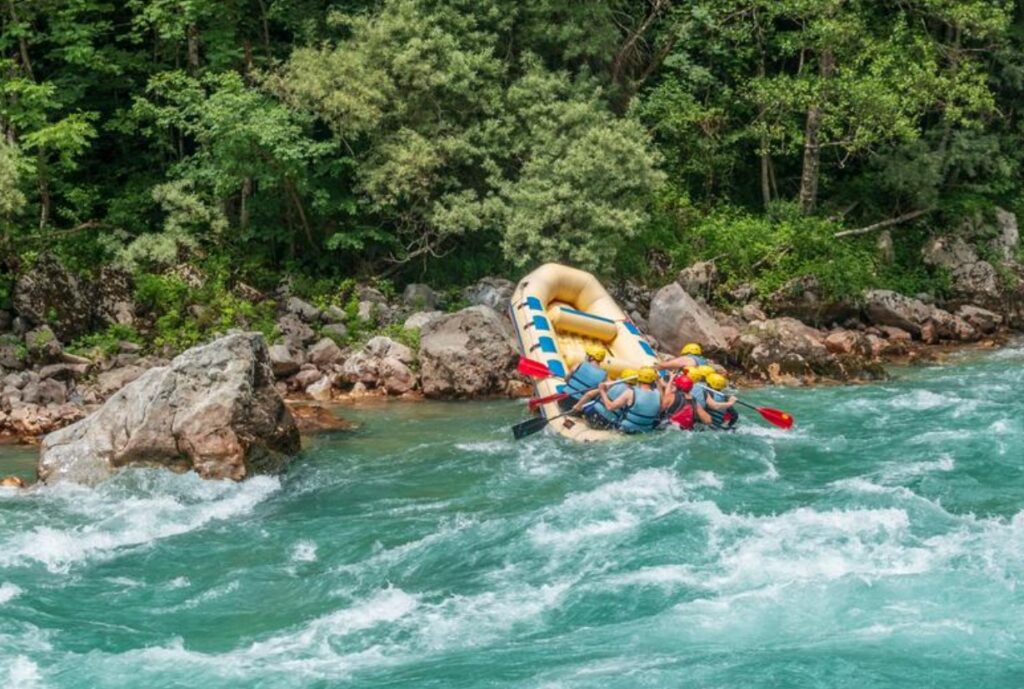
Swimming Safely in the River
When you land in the water there are two ways to navigate the river safely.
The ‘Down River Swimmers Position’ means you lie on your back with your head up so you can see where you’re going. Face your feet downstream and bend your knees slightly.
Using this technique, you can use your feet to propel you away from any rocks you encounter.
Keep your arms out to the side for balance and keep your butt raised.
The other swimmer’s position is ordinary breaststroke. Simply point to where you want to go and go fast. Never dilly-dally in the river current, it will sweep you away before you know it.
Don’t stand up in a moving current either, you can easily step into a crack in the riverbed and trap your foot. As a general rule don’t walk in water that’s deeper than your shins.
Master the ‘High Side’
‘High-side’ is a self-explanatory warning that your guide will give as a last attempt to stop the raft from capsizing. It doesn’t happen often but it’s important to work together if it does.
The only time the raft is likely to capsize is if it gets stuck on a rock. In these cases, water pressure builds up on the upstream side of the boat which can cause it to flip.
When this happens your guide will yell high side and you should throw your weight onto the downstream side of the craft i.e. the high side.
Don’t worry about this too much in advance. You’ll probably never need it and your guide will explain everything in your safety briefing.
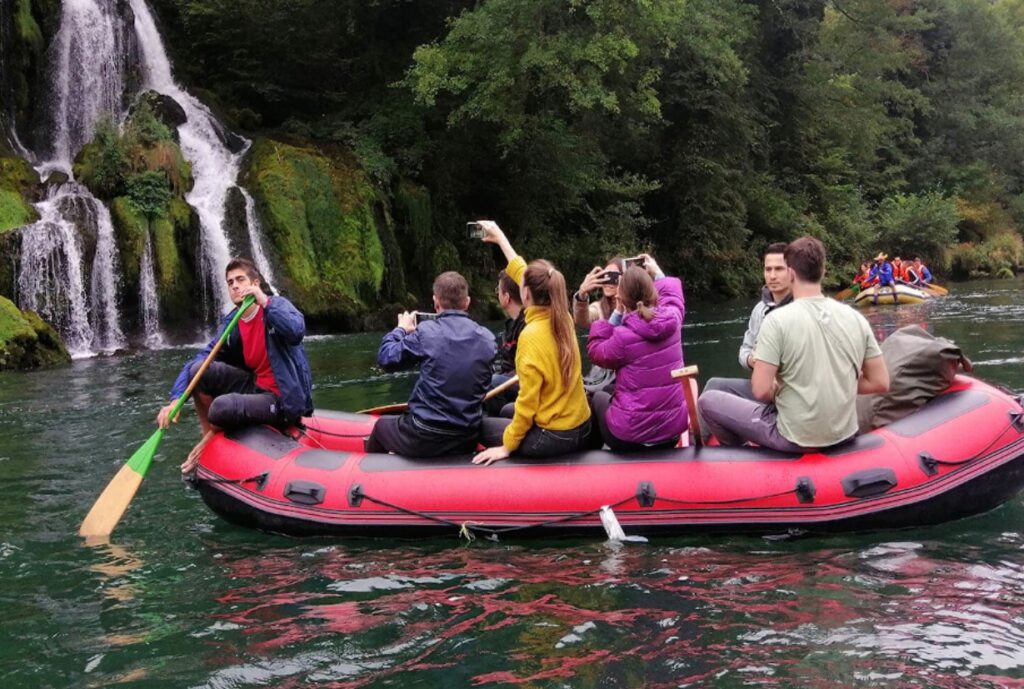
What to Bring on Your River Rafting Trip
There are a few essentials you’ll need for any river rafting excursion, regardless of how long it is.
Your outfitter will give you a list when you make your booking. Here’s a list of things you’re likely to need depending on the season.
Things to Bring along for Warm Weather Rafting
- Bathing suit
- Sunblock Sunglasses with straps, and lip balm
- River shoes, neoprene boots, or old sneakers
- T-shirt
- Two towels
- A warm waterproof jacket
- A waterproof camera
- A small dry bag and zip lock bags
- Extra water
Cold and Wet Weather Rafting Essentials
- Warm clothing
- Paddling pants
- A padded jacket
- A drysuit
- Neoprene gloves
- Neoprene booties
You can hire wetsuits, gloves, and booties from most outfitters but remember to bring some form of ID for hiring gear.
Remember the seasons aren’t the same everywhere you go rafting. A desert trip will differ vastly from a mountainside one any time of the year.
If you’re going on a day trip always bring a change of clothes. Part of the fun of rafting is getting soaked and you don’t want to drive home in wet clothing.
Don’t assume a wet suit will keep you dry, water always gets in somewhere.
There are a few things you should not bring along on a rafting trip. Leave your technology and music devices behind. Your phone won’t get reception and any gadgets could easily fall into the river.
Besides, most people want to enjoy the tranquil sounds of nature during their trip, not your collection of greatest hits.

Rafting Tips for Beginners
These are some of the best ways to make the most of your time on the river.
Pack light. You won’t end up wearing half the things you bring along with you. Although do bring a pair of jeans and a nice shirt for the evenings. You’ll need a break from wet rafting gear.
Don’t panic about bathroom activities. The river’s to hand for bathing as long as you avoid using soap and there is a rustic toilet at the campsites.
A pack of biodegradable baby wipes will do for tough dirt and there’s always dry shampoo if you want to keep your hair clean.
Most guides want you to have an unforgettable time so they recommend you bring yourself a small treat to celebrate your achievements. So pack in a bar of fancy chocolate or a small plastic bottle of expensive whisky to make the occasion extra special.
It’s also a good idea to bring a book or a journal along for those quiet times. On warm nights, skip the tent and sleep under the stars. You’ll be so glad you did.
Get Going!
If you enjoy a fair share of adrenalin, there’s a river out there somewhere with your name on it.
Why not pencil whitewater rafting in on your to-list for next year’s adventures or book your trip right away? Be warned though, it can get addictive.
Browse some more of our blog items for more on the best things to do and see all around the world.

